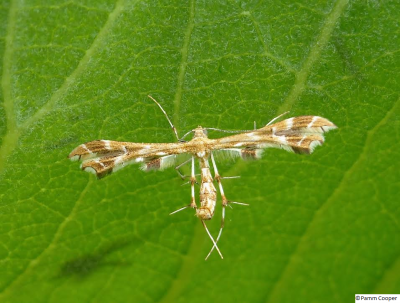(Geina persicelidactylus)

The grape plume moth is usually found feeding and webbing together leaves and shoots of grapes. This insect is more typically found on wild grapes than on cultivated varieties. Eggs are laid on the underside of young leaves. The newly-hatched larvae are slow, hairy, spindle-shaped, leaf rollers that feed on the upper grape leaf surfaces. Typically, a grape plume moth larva folds and webs the edges of a terminal leaf together and feeds within the fold. Older caterpillars may bore into the plant’s stem, flowers or seed pods. They exit the interior of the plant to form a pupa that hangs head-down from the underside of a leaf.
The grape plume moth overwinters in the pupal stage and the adult moths emerge during the spring. The larva is yellow with white hairs and about 5/8 of an inch long when fully grown. The adult moth is light brown with whitish markings and is half an inch long and there is one generation born each year.
The grape plume moth larvae rarely occur in large enough numbers to cause damage significant enough to justify control measures.
Despite good cultural practices, pests and diseases at times may appear. Chemical control should be used only after all other methods have failed. For pesticide information please call UConn Home and Garden Education Center or your local cooperative extension office.
The UConn Home & Garden Education Center supports UConn Extension’s mission by providing answers you can trust with research-based information and resources. For gardening questions, contact us toll-free at (877) 486-6271, visit our website at homegarden.cahnr.uconn.edu, or reach out to your local UConn Extension center at cahnr.uconn.edu/extension/locations.
Revised by the UConn Home and Garden Education Center, 2016.